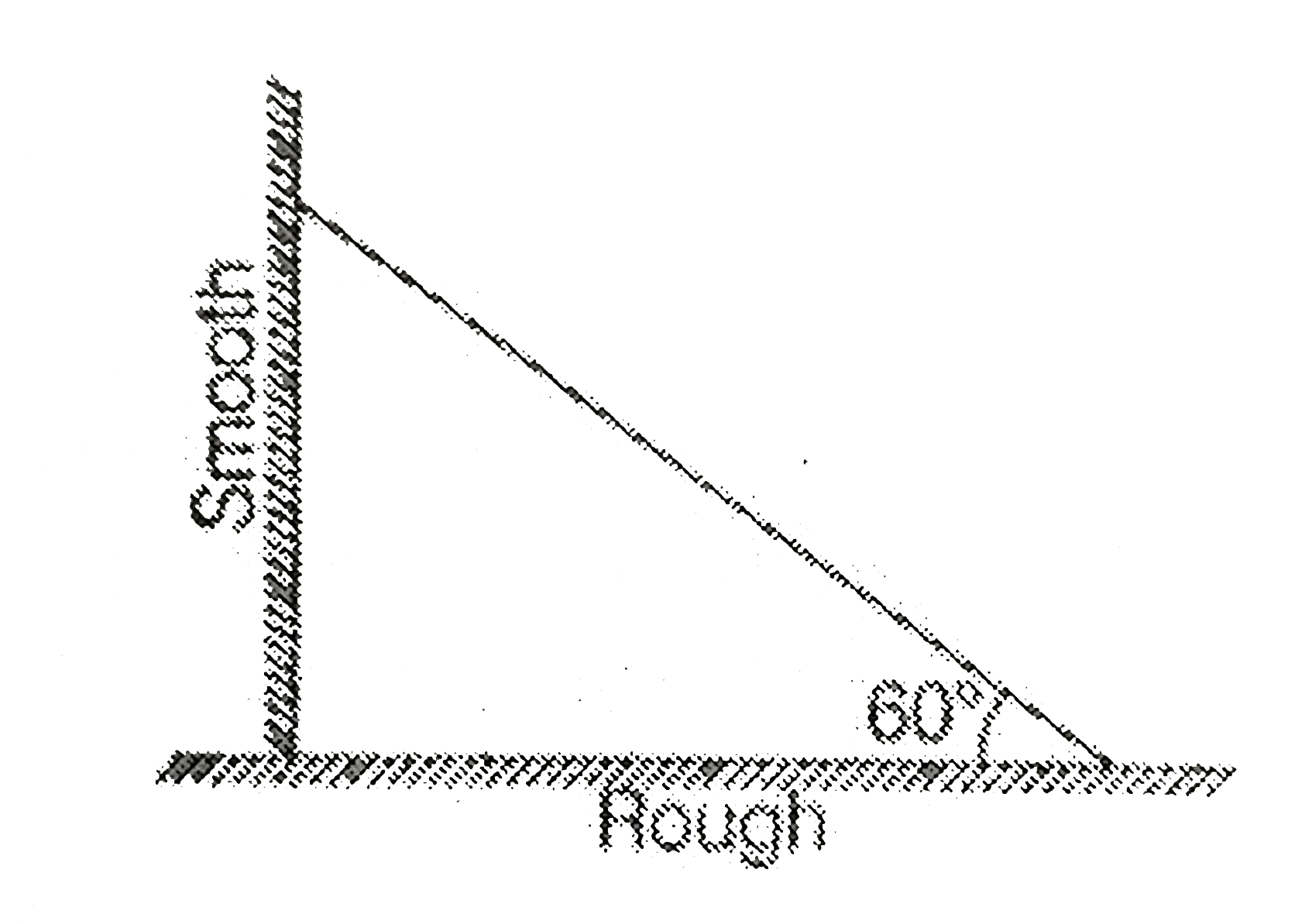A uniform ladder of mass 10 g leans against a smooth vertical wall making an angle of 530 with it. The other end rests on a rough horizontal floor. Find the normal force and the frictional force that the floor exerts on the ladder
N1=10g=100N

Balancing torque about A
10gl2cos37∘=N2lcos53∘
N2=2ω3N
Now f1N2=2003N
Topper's Solved these Questions
- RIGID BODY DYNAMICS 1BOOK - CENGAGE PHYSICSCHAPTER - RIGID BODY DYNAMICS 1EXERCISE - Exercise 2.4
11 Videos
- RIGID BODY DYNAMICS 1BOOK - CENGAGE PHYSICSCHAPTER - RIGID BODY DYNAMICS 1EXERCISE - Subjective
13 Videos
- RIGID BODY DYNAMICS 1BOOK - CENGAGE PHYSICSCHAPTER - RIGID BODY DYNAMICS 1EXERCISE - Exercise 2.2
17 Videos
- PROPERTIES OF SOLIDS AND FLUIDSBOOK - CENGAGE PHYSICSCHAPTER - PROPERTIES OF SOLIDS AND FLUIDSEXERCISE - INTEGER_TYPE
2 Videos
- RIGID BODY DYNAMICS 2BOOK - CENGAGE PHYSICSCHAPTER - RIGID BODY DYNAMICS 2EXERCISE - Interger
2 Videos
Similar Questions
A stationary uniform rod of mass 'm', length 'l' leans against a smooth vertical wall making an angle θ with horizontal floor. Find the normal force & frictional force that is exerted by the floor on the rod ?

View SolutionA ladder of mass 20 kg is resting against a vertical smooth wall. Ladder makes an angle 37° with the wall. Other end of the ladder is resting on a rough horizontal floor. Find normal force and force of friction applied on the ladder by horizontal surface.
View Solution
Knowledge Check
A ladder wighing 300 N is placed against a smooth vertical wall having a coefficient of friction between it and the floor of 0.2. What is the maximum force of friction available at the point of contact between the ladder and the floor?
A40 NB50 NC60 ND70 NA ladder of mass 10kg is held at reat against a smooth wall on a rough ground as shown in figure. The normal reaction between the wall and the ladder is
 A50NB50√3NC60√3ND100N
A50NB50√3NC60√3ND100NA ladder 20 ft long is resting angainst a smooth vertical wall at angle of 30∘ with it Its foot lies on a rough ground with coefficient of friction 0⋅3 If the weight of the ladder is 30 kg, then a man of 60 kg weight can climb on the ladder up to the height
A(9√3−5) ftB(9√3+√5)ftC9√3 ftDNone of these
A ladder 10m long is leaning against a vertical wall, it makes an angle of 60° with the ground.How far is the foot of the ladder from the wall?
View SolutionA uniform ladder of length L and mass m1 rests against a frictionless wall. The ladder makes an angle θ with the horizontal. (a) Find the horizontal and vertical forces the ground exerts on the base of the ladder when a firefighter of mass m2 is a distance x from the bottom. (b) If the ladder is just on the verge of slipping when the firefighter is a distance d from the bottom, what is the coefficient of static friction between ladder and ground?
View SolutionA uniform ladder of length 10.0 m and mas 16.0 kg is resting against a vertical smooth wall making an angle of 37∘ with it. An electrian weighing 60.0 kg climbs up the ladder. If the stays on the ladder at a point 8.00 m from the lower end, what will be normal force and the force of friction on the ladder by the ground? What should be the minimum coefficient of friction for the electician to work safely?
View Solution(i) A uniform ladder of length L and weight w rests against a vertical wall and makes an angle θ with the horizontal ground. If the coefficient of friction at the point of contact of the ladder with the wall and ground is μ, show that the greatest height x, measured along the ladder from the foot to which a man of weight w may climb without the ladder slipping is given by
xL=μ(W+w)W(1+μ2)(μ+tanθ)−w2W
(ii) If the wall be smooth and coefficient of friction between ladder and ground be 0.25, show that
x=L4(1−wW)tanθ−wL2W
View SolutionIn the figure, a ladder of mass m is shown leaning against a wall. It is in static equilibrium making an angle θ with the horizontal floor. The coefficient of friction between the wall and the ladder is μ1 and that between the floor and the ladder is μ2. the normal reaction of the wall on the ladder is N1 and that of the floor is N2. if the ladder is about to slip. than

View Solution
